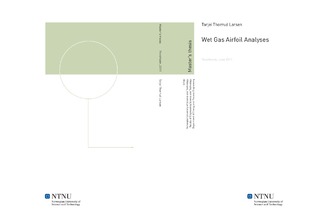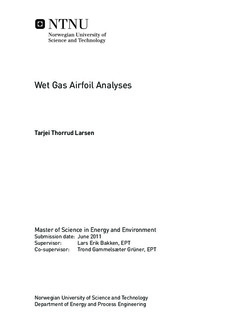| dc.contributor.advisor | Bakken, Lars Erik | nb_NO |
| dc.contributor.advisor | Gammelsæter Grüner, Trond | nb_NO |
| dc.contributor.author | Larsen, Tarjei Thorrud | nb_NO |
| dc.date.accessioned | 2014-12-19T13:52:46Z | |
| dc.date.available | 2014-12-19T13:52:46Z | |
| dc.date.created | 2011-09-20 | nb_NO |
| dc.date.issued | 2011 | nb_NO |
| dc.identifier | 442049 | nb_NO |
| dc.identifier | ntnudaim:5995 | nb_NO |
| dc.identifier.uri | http://hdl.handle.net/11250/257094 | |
| dc.description.abstract | Subsea wet gas compression renders new possibilities for cost savings and enhanced gas recovery on existing gas wells. Technology like this opens to make traditional offshore processing plants redundant. With new technology, follows new challenges. Multiphase flows is regarded as a complex field of study, and increased knowledge on the fundamental mechanisms regarding wet gas flow is of paramount importance to the efficiency and stability of the wet gas compressor. The scope of this work was to study liquid film flow in a diverging test-channel. The channel was designed to resemble conditions found over an airfoil or diffuser in a compressor, with emphasis on study the separation of the gas boundary layer over the thin liquid film. Boundary layer separation is closely connected to instabilities (surge) in compressors and is an important aspect to shed light on. Tools used were the CFD-software Ansys CFX 13.0. CFX was validated against experimental work were high speed camera was used in terms of flow visualization. In addition, two dynamic pressure sensors were used in the channel with the subsequent FFT-analysis, to study the influence of thin liquid films in a compression process, also related to instabilities. The CFD software has proven to give promising results on multiphase flows. From the CFD-simulations it was found a significant decrease in the shear stress in the gas phase over the liquid film, compared to air over a solid, smooth surface. This finding implies that the liquid film induces an increase in frictional losses for the gas phase, which leads to increased susceptibility for the gas phase to separate. The gas phase was, however, not found to separate with the given conditions. Visual similarities to the CFD-simulations were found from the high speed camera recordings. It was observed a clear void on the profile section with a substantial decrease in velocity, which can be related to boundary layer separation. These observations are supported by the smooth liquid film structure in this region. The FFT analysis shows a decrease in amplitude on the frequency spectra when increasing the liquid mass flow. | nb_NO |
| dc.language | eng | nb_NO |
| dc.publisher | Institutt for energi- og prosessteknikk | nb_NO |
| dc.subject | ntnudaim:5995 | no_NO |
| dc.subject | MTENERG energi og miljø | no_NO |
| dc.subject | Varme- og energiprosesser | no_NO |
| dc.title | Wet Gas Airfoil Analyses | nb_NO |
| dc.type | Master thesis | nb_NO |
| dc.source.pagenumber | 108 | nb_NO |
| dc.contributor.department | Norges teknisk-naturvitenskapelige universitet, Fakultet for informasjonsteknologi, matematikk og elektroteknikk, Institutt for elkraftteknikk | nb_NO |

